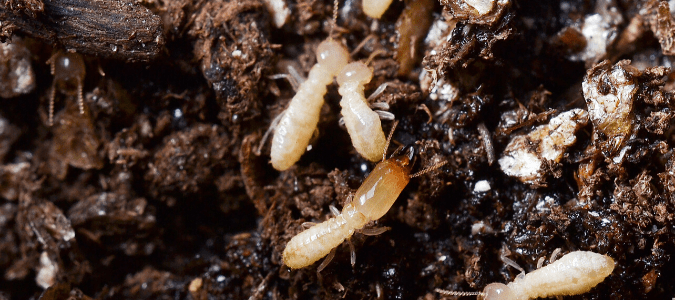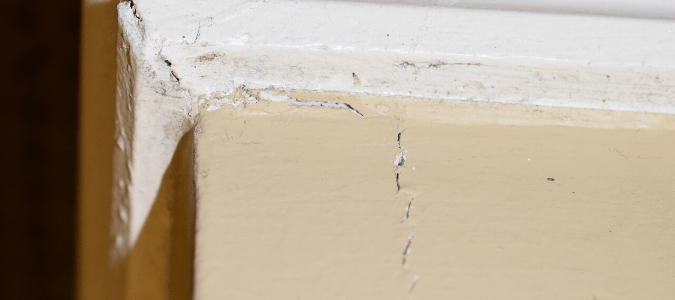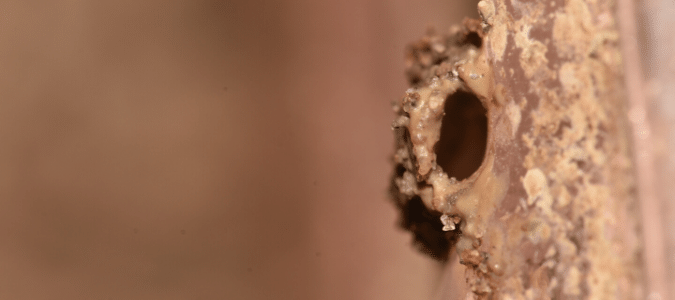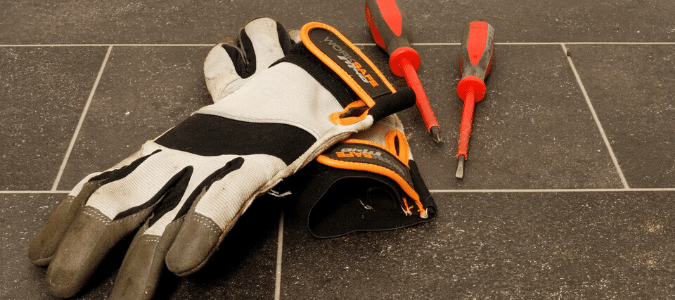
If you’ve ever dug into the mulch around your property, you’ve probably noticed that there are quite a few insects squirming around in the mulch. You may have even noticed one of the most destructive pests in the country—the termite. Upon this observation, you may start to wonder if mulch attracts termites. If so, should you remove it? Or, does finding termites in mulch serve as a warning sign that an infestation already taken place?
While termite control specialists advise against piling up mulch near the foundation of your home, it isn’t necessarily because the mulch attracts new termites from outside. What the presence of mulch against the home does do, however, is provide an environment that encourages existing termites to set up shop more permanently. In fact, any kind of organic matter near your home that remains moist can provide that necessary cover for a termite invasion.
Therefore, while mulch doesn’t attract termites or cause a termite colony to take up residence and grow, it does make it easier for them if all other circumstances are favorable. Moreover, having mulch, or any other organic matter, next to your home’s foundation provides a barrier that can make it more difficult to detect these unwanted visitors until extensive damage has been done.
The three main things you should keep a lookout for that can attract termites to your home are excess moisture, wood that is in direct contact with the soil and cracks or holes along the exterior of your home. If you have any of those issues on your property, you should address them immediately. If you don’t, you run the risk of extensive damage to your biggest investment.
In this post, we’ll review some of the most common questions homeowners have about termites, such as how to tell if you have an infestation, how to check for these pests and why termites might be in your ceiling.

What Does It Mean To Have Termites In Your Ceiling?
If a termite colony has made its way to the highest part of your home, chances are you’ve got a big problem on your hands. Why? Because more often than not, the ceiling isn’t a termite’s first destination. Since subterranean termites live underground, termite damage in ceilings is an indicator that a colony is well established and you probably have extensive activity throughout your home.
Initially, you may notice something that looks like light water damage on your ceiling that could be a sign of termites. In some cases, your drywall or paneling may sag or somehow appear misshapen. Typically the area will also appear discolored due to damage just above the surface of your ceiling. Keep in mind that subterranean termites dry out above ground, so you are more likely to see the mud tubes that serve as their passageways in these areas that are moist enough to keep them alive rather than the termites themselves.
Ignoring these issues could leave you facing worsening conditions, whether it’s actually due to a water leak, termites or some other kind of pest. It’s best to investigate as soon as you notice an issue. If upon further inspection you find no signs of water leaks or other damage associated with excess moisture, you could be looking at termite damage on your ceiling.
While it is possible for drywood termites to have made their way directly into the ceiling either by landing on your roof during a swarming period or by way of a bridge (a tree branch that touches your house, for instance), the type of termite you should be most worried about won’t often arrive that way: subterranean termites.
As we’ve mentioned, subterranean termites work and eat from the ground up. Spotting subterranean termites in your ceiling means that these destructive insects have worked their way through the lower portions of your home. Most likely, your ceiling was just next on the menu. That being said, above ground infestations are almost always in areas with ongoing moisture problems, including where leaves gather on a flat roof, near leaking pipes and in poorly-ventilated crawl spaces, so not usually on ceilings.
There are other ways termites can enter your home other than through your foundation. Many homeowners like having tall trees in close proximity to their home and, more specifically, their windows for security and privacy purposes. Unfortunately, if you can touch the tree branch right outside of your window, there’s a good chance that you are unknowingly providing a bridge for termites into your home.
Also, what do we typically store in attics? Boxes. Old clothes. Maybe old books or magazines. Many of these items contain cellulose—the preferred food source of termites. Have you heard of cellulose insulation? Termites will eat that, too. These pests will chew through nearly anything, from your drywall and wood beams to your cardboard storage boxes and on through your prized books, papers and other cellulose-laden possessions.
While you’re waiting for a professional to arrive to inspect your home for termites, we recommend you spend some time looking for signs in and around your home for termite damage.

What Do Signs Of Termite Sawdust Indicate?
One of the most common ways to identify drywood termite activity is finding termite sawdust. Visible to the naked eye, these materials are usually actually termite frass, which is a scientific way of saying poop. While it’s gross if you think about it too much, sawdust is also one of the most common ways people end up discovering a drywood termite problem.
How do you find this material in your home? Scan surfaces for tiny tan and black fecal droplets. Frass usually looks like sawdust, as the name would suggest, but it does vary, depending on the type of wood or other cellulose sources the termites have been eating. Termite droppings range from blonde or honey-colored to dark brown or black. Sometimes homeowners report finding a combination of colors.
While a single pellet is smaller than a pinhead, you may find what looks like small clumps or piles of droppings on your floor, on top of dressers or even on your bedspread if the termites are in your ceiling.
In other areas of your home, you may find large piles built up near gallery holes. Gallery holes are how drywood termites keep their galleries, or tunnels, clean. These termites push the frass out, forming large piles along walls and in abandoned corners of your home.
Another pest that can damage a home, leaving behind sawdust-like material, are carpenter ants. These waste products actually look quite different than termite frass, however. While drywood termites tend to leave behind six-sided pellets, ant feces are fibrous and can contain fragments of wood, soil and even insect parts. A pest control professional can easily distinguish between termite and ant droppings.
Termite frass isn’t the only potential sign of activity in and around your home.

Termite Mud Tunnels: Another Warning Sign
As we have mentioned previously, the vast majority of termite damage comes from subterranean termites. As their name implies, these insects need to stay underground and they only come into a home to feed. Additionally, subterranean termites have to stay moist. If these termites are exposed to dry air and light for too long, they die.
So, in order to infest a home, subterranean termites have to create mud tunnels. These are exactly what they sound like—thin, cylindrical tubes made of “mud” (actually a combination of soil and fecal matter) that you will likely find outside along the foundation of your home if you have an infestation. These tubes allow termites to travel from moist soil to damp or rotten wood without exposure to dry air and light. These mud tubes can become extensive and lead to many different areas around your home.
Locating these mud tunnels is just one way to check for termites.

How To Check For Termites
While many government agencies, including the Environmental Protection Agency, advise homeowners to contact a reputable pest control agency if they suspect termite activity, it’s understandable to conduct your own inspection while you are waiting for help to arrive. A do-it-yourself termite inspection involves a few specific tools you probably already have at home, along with some inside knowledge on where to look and a fairly clear expectation of what you might find.
Before you get started, we recommend gathering up the following tools before you perform a walkthrough inside and outside your home:
- A good, strong flashlight
- A long, thin screwdriver or pocket knife
- Gloves
- A disposable surgical mask, in case you come in contact with dust or other debris
If you plan on inspecting your home, you’ll want to check both the interior and exterior surfaces. In particular, you’ll be paying special attention to those places where a structure touches the soil, plants and other wood structures, often at ground level. This includes:
- Any wood construction in basements and crawl spaces
- All window sills and every structure related to the framing of your home
- Wooden porches, steps and fences
- Hollows of cinder blocks or bricks, cracks in cement or brick construction
- Any wood scraps, dead tree stumps or other plant debris close to the home
Besides termite frass and mud tunnels, signs of termites you’ll be looking for include damaged wood, piles of termite wings and active termites in and around the house. Keep in mind that there is a very small window that most of us see termites, which is during swarming season, which is typically a few weeks during the spring.
Search for chipping or bubbled paint and tiny holes along wooden surfaces. Specifically, look closely in areas near load-bearing points which may appear crushed. When you come across any of these signs, tap the wall with your screwdriver or knife. Sound hollow? Investigate further. See if you can’t pick or probe the surface you believe to be infested. You may uncover termite tunnels just beneath the surface.
During termite mating seasons, termites swarm. When swarmers land, their wings fall off. Check window sills and baseboard corners for piles of shed wings. This is a fairly positive indication that you have termites in your home.
Obviously, if you actually see live termites you can confirm they’re in your home. It’s easy to confuse them with other insects, though, so you may need a second opinion from a professional.
ABC Can Protect Your Home From Termites
Diagnosing a termite problem can be difficult for a homeowner to do and, many times, termite colonies can grow to have over a million members before they are discovered. If you believe you may have termites nesting on your property, contact the professionals at ABC Home & Commercial Services. Our highly trained specialists will be able to quickly locate where these termites are hiding, then get to work on eliminating them from your property.
